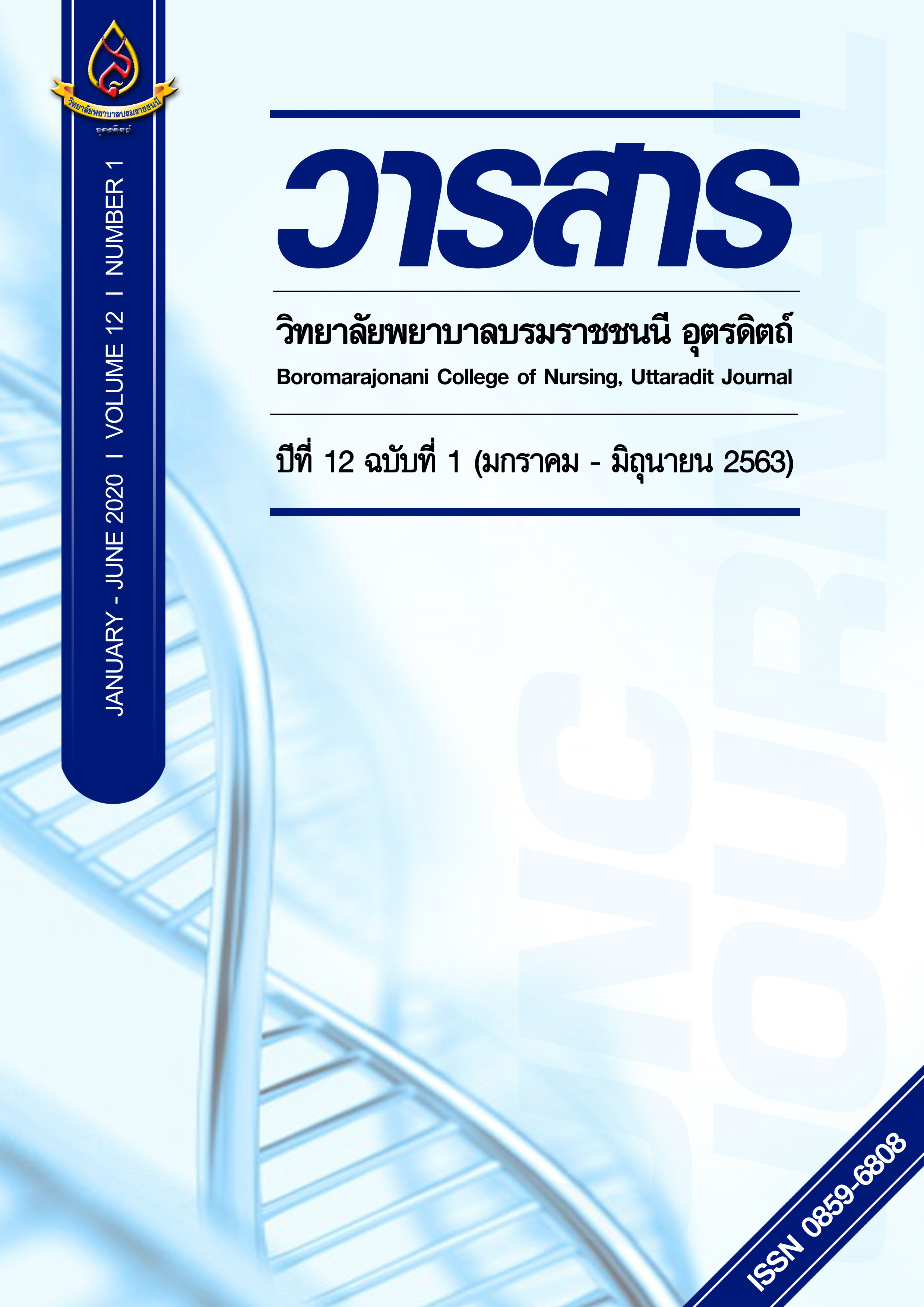การประยุกต์ใช้รูปแบบการประเมินผลกระทบต่อครอบครัวที่มีผู้ป่วยโรคเรื้อรัง: การนำผลงานวิจัยไปใช้ประโยชน์
Main Article Content
บทคัดย่อ
บทความนี้มีวัตถุประสงค์เพื่อนำเสนอถึงการนำผลงานวิจัยไปใช้ประโยชน์ ได้แก่ การนำรูปแบบการประเมินผลกระทบต่อครอบครัวที่มีผู้ป่วยโรคเรื้อรัง (FIACI model) ที่พัฒนาขึ้น ไปประยุกต์ใช้ในการจัดการศึกษาทางการพยาบาลโดยการบูรณาการผลงานวิจัยในการจัดการเรียนการสอนรายวิชาปฏิบัติการพยาบาลครอบครัวชุมชน 1 จากผลการประเมินพบว่าการนำรูปแบบการประเมินผลกระทบต่อครอบครัวที่มีผู้ป่วยโรคเรื้อรังไปใช้ในการจัดการเรียนการสอนภาคปฏิบัติการพยาบาลครอบครัวชุมชน 1 นั้นทำให้นักศึกษามีแนวทางในการประเมินผลกระทบต่อครอบครัวที่มีผู้ป่วยโรคเรื้อรังได้อย่างครอบคลุม ส่งเสริมให้นักศึกษามีความคิดวิเคราะห์และสามารถวางแผนการพยาบาลจากปัญหาที่พบในแต่ละครอบครัวได้อย่างมีประสิทธิภาพ
Article Details
บทความหรือข้อคิดเห็นใดใดที่ปรากฏในวารสารวิจัยการพยาบาลและวิทยาศาสตร์สุขภาพ เป็นวรรณกรรมของผู้เขียน ซึ่งบรรณาธิการหรือสมาคมศิษย์เก่า ไม่จำเป็นต้องเห็นด้วย และบทความที่ได้รับการตีพิมพ์เผยแพร่ถือเป็นลิขสิทธิ์ของวารสารวิจัยการพยาบาลและวิทยาศาสตร์สุขภาพ
เอกสารอ้างอิง
Abegunde, D.O. & Stanciole, A.E. (2008). The economic impact of chronic diseases: how do households respond to shocks? Evidence from Russia. Social Science & Medicine, 66, 2296-307.
Anderson, J. & Malone, L. (2015). Chronic care undergraduate nursing education in Australia. Nurse Education Today, 35(12), 1135-1138.
Bowen, C., MacLehose, A. & Beaumont, J.G. (2011). Advanced multiple sclerosis and the psychosocial impact on the families. Psychology Health, 26(1), 113-127.
CDC. (2019). Health and economic cost of chronic diseases. Retrieved (2019, March 3) from https://www.cdc.gov/chronicdisease/about/index.htm
Basu, S. (2013). The changing landscape of non-communicable disease associated risk factor. Population Division: Expert paper, United Nations: Department of Economic and Social Affairs.
Block, R.C., Tran, B. & Mcintosh, S. (2011). Integrating the chronic care model into a novel medical student course. Health Education Journal, 70(1), 39-47.
Bodenheimer, T., Wagner & Grumbach, K. (2002). Improving primary care for patients with chronic illness: the chronic care model part 2. JAMA, 288(15), 1909-14.
Davy, C., Bleasel, J., Liu, H., Tchan, M., Ponniah, S. & Brown, A. (2015). Effectiveness of chronic care models: opportunities for improving healthcare practice and health outcomes: a systematic review. BMC health services Research, 15(1), 194 – 204.
Geneau, R., Stuckler, D., Stachenko, S., et al. (2010). Chronic diseases: chronic diseases and development 1: raising the priority of preventing chronic disesses: a political process. The Lancet, 376(9753), 1689-98
Golics, C.J., Basra, M.K.A., Finlay, A.Y. & Salek, S. (2013). The impact of disease on family members: a critical aspect of medical care. Journal of the Royal Society of Medicine (JRSM), 106(10), 399-407.
Golics, C.J., Basra, M.K.A., Salek, S.M. & Finlay, A.Y. (2013). The impact of patients’ chronic disease on family quality of life: an experience from 26 specialties. International Journal of Medicine, 6, 787-798.
Higuchi, M. (2010). Lifestyle Diseases: Access to chronic Disease Care in Low and Middel income countries. UN Chronicle, 47(2).
Leow, M.Q.H. & Chan, S.W.C. (2011). Factors affecting caregiving burden of terminally ill adults in the home setting: A Systematic review. JBL library of Systematic Reviews, 9(45), 1883 – 1916.
Mahal, A., Karan, A. & Engergau, M. (2010). The economic implication of non-communicable disease for India. Washington: World Bank.
Maschio, G., Silvia, A.M., Celich, K.L.S., et al. (2019). The Family Relationship When Dealing with a Chronic Disease: The Family Caregiver Viewpoint. RevFundCareOnline, 11(n.esp), 470-474.
Mathers, C.D., Loncar, D. (2006). Projections of global mortality and burden of disease from 2002 to 2030. PLOS Medicine, 3, e442
Nugent, R. (2008). Chronic disease in developing countries: health and economic burdens. Annals of the New York Academy of Sciences, 1136, 70-79
Oliva, N.L. (2008). The impact of RN case management on inpatient and ED utilization in a chronically ill, older adult, community-dwelling population. United States: California: University of California, San Francisco.
Oupra R. & Amattayakong G. (2009). The Impact on the family providing care for stroke survivors at home [Clinical Research ]: Boromarajonani College of Nursing ChiangMai .
Oupra R, Griffiths R, Pryor J & Motts S. (2010). Effectiveness of supportive educative learning programme on the levelof strain experienced by caregivers of stroke patients in Thailand. Health and Social Care in the Community, 18(1), 10-20.
Stellefson, M., Dipnarine, K. & Stopka, C. (2013). The Chronic care model and diabetes management in US primary care settings: A systematic review. Preventing Chronic : Public Health Research, Practice and Policy, 10 (120180).Retrieved (2019, May 24) from http://dx.doi.org/10.5888/pcd10.120180.
Strategy and Planning Division, Ministry of Public Health. (2017). Public health statistics A.D. 2017. Ministry of Public Health Thailand: Nonthaburi. ISSN 0857-3093
World Health Organization. (2008).World Health statistics 2008. Geneva: World Health Organization.
World Health Organization.(2015). Non communicable diseases. Retrieved (2019, March 13) from http://www.who.int/mediacentre/factsheets/fs355/en
World Health Organization. (2018). The top 10 causes of death. Retrieved (2019, March 13) from https://www.who.int/mediacentre/factsheets/fs310/en/index3.html


